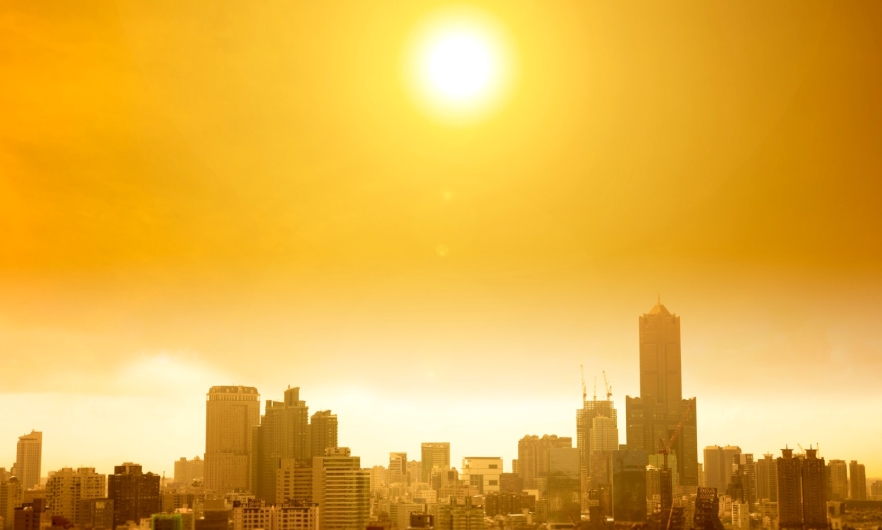Study: Cities Not Fully Engaging Public Health Agencies in Climate Change Planning
Review of 22 large cities in 14 countries identifies shortfalls in reported public health agency involvement in climate-change adaptation plans

Climate-change adaptation efforts by governments in large cities around the world have not been enlisting the participation of public health agencies as much as they could, according to a study led by researchers at the Johns Hopkins Bloomberg School of Public Health.
The researchers examined extreme-weather preparedness and other climate-change resilience efforts in 22 large cities in 14 countries and found that more than one-quarter did not report involvement of a public health agency. Sixteen of the 22 cities—73 percent—assessed in the study reported having a public health department on their climate-plan teams.
Among the researchers’ conclusions is that the limited role of public health agencies in these climate-adaptation programs contrasts with the programs’ central purpose of protecting health and well-being.
The study was published online March 3 in PLOS Climate.
“Including a public health perspective in these critical planning stages can help ensure that climate adaptation efforts are targeted to the most vulnerable communities, so these agencies shouldn’t be on the sidelines,” says study first author Mary Sheehan, PhD, MPH, an associate in the Department of Health Policy and Management at the Bloomberg School. “What we found represents a big opportunity for increasing their involvement to enhance impact and to help reduce inequalities.”
Concerns over the effects of climate change, including rising sea levels and more frequent heat waves, floods, and other extreme weather events, have led many local governments around the world to devise programs to mitigate and manage these effects, in large part to protect the health of their citizens. In the study, the researchers examined the participation of public health agencies in these efforts in large cities.
For their analysis, the researchers looked at city climate-change adaptation plans. In order to detect public health engagement, they selected the cities with relatively extensive health-associated climate change adaptation programs with plans that were publicly available as of 2016.
The 22 cities reviewed in the study included 16 in high-income countries (Austin, Auckland, Baltimore, Barcelona, Boston, Calgary, Las Vegas, Lisbon, London, Paris, Phoenix, Salt Lake City, San Francisco, Tel Aviv-Yafo, Vancouver, and Washington, D.C.) and six in low- or middle-income countries (Buenos Aires, Cape Town, Hong Kong, Kolkata, Quezon City, and Rio de Janeiro).
For each city, the researchers combed climate adaptation plans to identify reports of at least one of five different types of health-related climate change adaptation activities: hazard and vulnerability mapping; extreme weather preparedness and response; extreme heat early warning and action plans; non-heat early warning (for flooding or landslides, for example); and climate-related health surveillance.
All 22 cities reported active efforts in at least two of these five categories, and 90 percent reported efforts in at least three. Yet the rate of reported public health department involvement in these activities was relatively low: just 59 percent for extreme heat actions, 45 percent for preparedness and health surveillance actions, 41 percent for hazard and vulnerability mapping actions, and 14 percent for non-heat early warning actions. Extreme weather preparedness can involve as many as a dozen different agencies, the authors note. The analysis found multi-agency collaboration was evident across categories.
Of the cities in the sample, Baltimore and Rio de Janeiro reported plans that included public health involvement in all five action categories. Barcelona, London, and Quezon City, in the Philippines, reported involvement in four categories, while Kolkata, India, San Francisco, and Washington, D.C., reported involvement in three categories.
The analysis also suggested that, even when a public health agency was engaged in a city’s climate-related health plan, its involvement was less extensive than it could have been. For extreme heat plans, for example, public health agency engagement was often limited to public communication about risks and typically did not extend to the city’s efforts to reduce heat risk through “greening”—planting trees, adding parks—or better urban design.
“Public health agencies are needed not only for targeting activities to the most vulnerable but also for surveillance and evaluating health outcomes after events to see if an intervention is, in fact, working—and we don’t see a lot of public health agency involvement at this level,” says senior author Mary Fox, PhD, MPH, assistant professor in the Bloomberg School’s Department of Health Policy and Management.
The researchers make recommendations in the paper for enhancing public health agency involvement in city climate adaptation plans, including engaging public health more robustly in vulnerability mapping; identifying barriers to and facilitators of city health department integration into climate adaptation planning; and focusing more on cities in low- and middle-income countries—where, in the study’s small sample, public health agency involvement in the five activities was more commonly reported than it was in high-income countries.
The researchers are now studying the roles of public health agencies in climate-change adaptation efforts in low- and middle-income countries in particular.
“Urban climate-health governance: Charting the role of public health in large global city adaptation plans” was written by Mary C. Sheehan, Fay Khudairi, Gurtejandeep S. Swaich, William Hines, Shivani Mehta, and Mary A. Fox.
Sheehan and Fox’s co-authors were MPH students at the Bloomberg School at the time the study was conducted.
# # #
Media contacts: Caitlin Hoffman at choffman@jhu.edu and Carly Kempler at ckemple2@jhu.edu.





